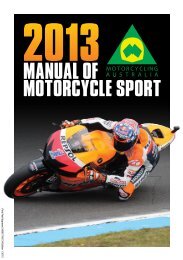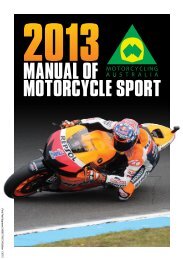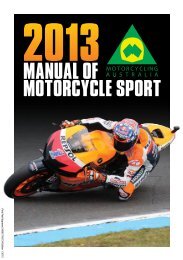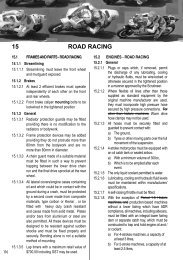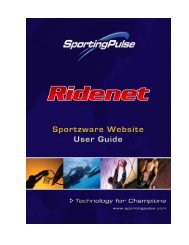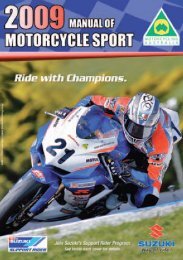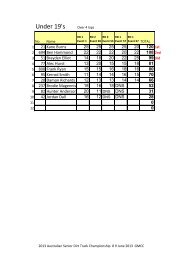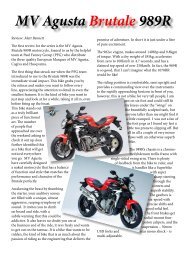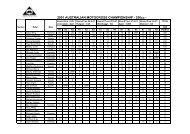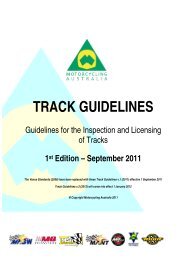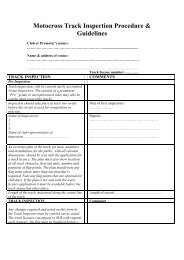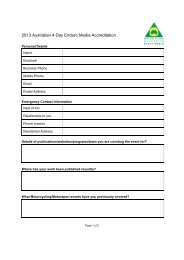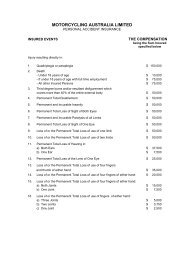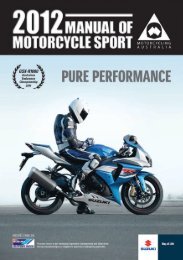2008 Manual of Motorcycle Sport - Motorcycling Australia
2008 Manual of Motorcycle Sport - Motorcycling Australia
2008 Manual of Motorcycle Sport - Motorcycling Australia
You also want an ePaper? Increase the reach of your titles
YUMPU automatically turns print PDFs into web optimized ePapers that Google loves.
Fig 19.3.2.4 Carburettor dimensions<br />
19.3.3 Sidecar<br />
19.3.3.1 An event may be restricted to machines <strong>of</strong><br />
a capacity <strong>of</strong> no more than 500cc, which<br />
will be known as a 500cc class event.<br />
19.3.3.2 For a machine competing in a 500cc<br />
class event, the engine must comply as<br />
follows:<br />
a) Where electronic fuel injection is<br />
installed, it must be <strong>of</strong> a standard<br />
production type,<br />
b) The engine may not be turbocharged<br />
or supercharged.<br />
19.3.3.3 For a machine competing in any event<br />
other than a 500cc class event, the engine<br />
must comply as follows:<br />
a) The engine capacity must not<br />
exceed 1,045cc,<br />
b) Supercharged and turbocharged<br />
engines must not exceed 500cc,<br />
c) On liquid cooled engines an overflow<br />
pipe must be used to direct any<br />
overflow <strong>of</strong> coolant away from the<br />
rider and passenger.<br />
d) Titanium may be used if fitted as OEM.<br />
19.4 Engines - Junior speedway<br />
19.4.1 125cc Solo<br />
19.4.1.1 If the engine is fitted with a gearbox, the<br />
gearshift lever must be removed and the<br />
machine must remain in 1 gear while<br />
racing.<br />
19.4.1.2 The engine capacity must not exceed<br />
125cc with a +1mm tolerance <strong>of</strong> the bore<br />
diameter.<br />
19.4.1.3 A single cylinder, 4-stroke<br />
engine, fitted with 1<br />
carburettor, <strong>of</strong> a mass<br />
produced type must be<br />
used.<br />
19.4.1.4 The cylinder head must<br />
be as follows:<br />
a) 2-, 3- or 4-valve<br />
cylinder heads can<br />
be fitted, but 3- and<br />
4-valve heads must<br />
retain manufacturers<br />
specifications,<br />
b) The action <strong>of</strong> the valves must be<br />
controlled by valve springs,<br />
c) The cylinder head may be ported<br />
and, if damaged in use, bearing<br />
journals may be bored and bearings<br />
replaced with either roller or bronze<br />
bearings,<br />
d) For 2-valve heads, maximum valve<br />
size must be:<br />
i) Exhaust - 25mm, and<br />
ii) Inlet - 30mm.<br />
19.4.1.5 Carburettors no bigger than 24mm can be<br />
fitted.<br />
19.4.1.6 Inlet manifold must be round for entire<br />
length.<br />
19.4.1.7 Early model crankcases may be used with<br />
late model heads but the compression<br />
ratio must not exceed 9.7:1.<br />
19.4.1.8 Any type <strong>of</strong> ignition system may be used.<br />
19.4.1.9 Later model parts, or parts <strong>of</strong> different<br />
manufacture, may be installed.<br />
19.4.1.10 The “Shupa” brand junior Speedway<br />
machine is approved for competition in the<br />
Junior 125 Solo class when the machine<br />
is fitted with the 2- or 3-valve head.<br />
19.4.2 Junior - Sidecar<br />
19.4.2.1 Engine capacity must not exceed 250cc.<br />
19.4.2.2 Machines must be fitted with unmodified<br />
production engines and may be fitted with<br />
an operating gearbox.<br />
19.4.2.3 Junior sidecar competitors on junior<br />
sidecar machines are allowed to practice<br />
on senior tracks. NOTE: Both rider and<br />
passenger must be aged 15 years, and<br />
only 1 machine at a time is allowed.<br />
19 speedway<br />
<strong>2008</strong> MANUAL OF MOTORCYCLE SPORT enjoy the ride<br />
169




